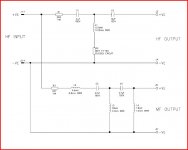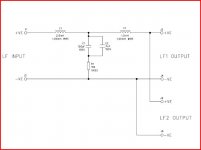2) MOSFETs in series. RDSon in order of tens of milliohms.
You mean less than 10mOhm, over a decade ago, mate.
See => http://www.nxp.com/documents/data_sheet/PSMN009-100W.pdf
"Nowadays" it's under 5mOhm Rds(on) for 100V/200A biggies.
Last edited:
Mosfet SSR circuit
I reckon that Mosfet SSR circuit needs a bit of polish...
Under a DC fault, you have to interrupt several amps with several mH of loudspeaker load, and the resulting back-emf will easily exceed the MOSFET's Vds (60V for IRFZ48). So your rails should be less and I would add some zeners or MOV's to deal with the spike.
PV opto-couplers usually require gate bleed resistors (~1-10Meg) to quicken MOSFET switch-off time and keep the gate from floating.
I reckon that Mosfet SSR circuit needs a bit of polish...
Under a DC fault, you have to interrupt several amps with several mH of loudspeaker load, and the resulting back-emf will easily exceed the MOSFET's Vds (60V for IRFZ48). So your rails should be less and I would add some zeners or MOV's to deal with the spike.
PV opto-couplers usually require gate bleed resistors (~1-10Meg) to quicken MOSFET switch-off time and keep the gate from floating.
HI Prairiemystic,
To address your issues, as I already stated in previous posts, I've been using this circuit for years, and have never had any issues. Also, it's easily scaleable for higher currents and/or voltages, the IRF48V has been around for a while, the technology has improved greatly since then. As far as the inductive kick-back issue, I too questioned weather they would hold up under harsh conditions, so I did everything I could think of to fry them using an old amp I was willing to sacrifice driving a woofer with relatively high inductance. I repeatedly connected and disconnected at full power, short circuited, applied large DC directy into output, nothing seemed to faze them. And did all that without protection diodes shown in final version. As Andrew T. pointed out earlier, they activate in a few miliseconds and release in sub-miliseconds. I suggest that everyone just try the circuit as is before concluding there are problems, and applying all kinds of "fixes". It's very easy and cheap to throw together on a test jig and check it out.
Mike
To address your issues, as I already stated in previous posts, I've been using this circuit for years, and have never had any issues. Also, it's easily scaleable for higher currents and/or voltages, the IRF48V has been around for a while, the technology has improved greatly since then. As far as the inductive kick-back issue, I too questioned weather they would hold up under harsh conditions, so I did everything I could think of to fry them using an old amp I was willing to sacrifice driving a woofer with relatively high inductance. I repeatedly connected and disconnected at full power, short circuited, applied large DC directy into output, nothing seemed to faze them. And did all that without protection diodes shown in final version. As Andrew T. pointed out earlier, they activate in a few miliseconds and release in sub-miliseconds. I suggest that everyone just try the circuit as is before concluding there are problems, and applying all kinds of "fixes". It's very easy and cheap to throw together on a test jig and check it out.
Mike
Mosfets (Trench technology) are rated for inductive load dump and this is usually spec'd as a mJ rating. For one off inductive energy dumps they can take a hell of a hammering. For example, on critical ABS systems they do not use flyback diodes around the solenoids ( and we are talking significant Amps here). The devices are fully characterized for this environment and the auto guys do not take chances. While a speaker acoss 75V is also a lot of energy, if you stay within the load dump rating and worst case Vds spec (assume 2x your amp supply rail) you should be good to go.
Last edited:
I'm just saying I'd put clamp diodes on them. 55/60V MOSFETs are avalanche rated (typ. for 12V automotive use) but... IRFZ48 max. 0.1mJ at VDD=25V, L=22uH, Ias=72A; With +/-50V rails, 2.1mH woofer+4mH xover, 6 ohm, I get about 0.21mJ
Why not move these mosfets in series with the output stage transistors, just switching off the rails there when a fault happens. NFB would cover the on-resistance and also assuming shorted drivers could not hit the loudspeaker.
Why not move these mosfets in series with the output stage transistors, just switching off the rails there when a fault happens. NFB would cover the on-resistance and also assuming shorted drivers could not hit the loudspeaker.
Hi All,
The idea of using MOSFET switches before the power outputs has merit with a couple of possible caveats. For that application, it would be important to put them between the output devices (or the power pins on chip amps) and the power supply decoupling caps that pretty much all amps have, and I think it would be best to use surface mount MOSFETs to keep added inductance as low as possible. And just to be clear, I'm not specifically recommeding the IRFZ48V, it was the best I could find when I built mine years ago, many far superior devices are available today.
Mike
The idea of using MOSFET switches before the power outputs has merit with a couple of possible caveats. For that application, it would be important to put them between the output devices (or the power pins on chip amps) and the power supply decoupling caps that pretty much all amps have, and I think it would be best to use surface mount MOSFETs to keep added inductance as low as possible. And just to be clear, I'm not specifically recommeding the IRFZ48V, it was the best I could find when I built mine years ago, many far superior devices are available today.
Mike
Sad news..
I fitted the new bass drivers.
Looks like the mid range and/or tweeter is also damaged. The affected speaker has a very flat sound and the top end is quite muffled. I need to do some more tests tonight.
I fitted the new bass drivers.
Looks like the mid range and/or tweeter is also damaged. The affected speaker has a very flat sound and the top end is quite muffled. I need to do some more tests tonight.
By the cringe, you have to admit there's a lot to be said for the "old" cap coupled amps 😉
Yes. They have their merits.
I'm just saying I'd put clamp diodes on them. 55/60V MOSFETs are avalanche rated (typ. for 12V automotive use) but... IRFZ48 max. 0.1mJ at VDD=25V, L=22uH, Ias=72A; With +/-50V rails, 2.1mH woofer+4mH xover, 6 ohm, I get about 0.21mJ
Why not move these mosfets in series with the output stage transistors, just switching off the rails there when a fault happens. NFB would cover the on-resistance and also assuming shorted drivers could not hit the loudspeaker.
Also a good idea prairiemystic. You can just switch the whole amp supply on and off. I took a look at this yesterday and that's another option I am exploring now.
Overcomplicated power amplifier designs are prone to HF oscillations under critical conditions. That is one of the main reasons why race for lowest THD does not necessarily result in a reliable amplifier.
I use a PIC micro to monitor the output volts, if it see DC for 500mS it opens the relay.
The PIC also holds off the relay for 3 seconds on power up.
However I would not just relky on this and use fuses as well.
I also never use low power speakers, my speakers are always rated at twice the power of the amplifier.
The PIC also holds off the relay for 3 seconds on power up.
However I would not just relky on this and use fuses as well.
I also never use low power speakers, my speakers are always rated at twice the power of the amplifier.
Sad news..
I fitted the new bass drivers.
Looks like the mid range and/or tweeter is also damaged. The affected speaker has a very flat sound and the top end is quite muffled. I need to do some more tests tonight.
That's bad new... hope it's just an easy fix
Attachments
Update. When I mentioned that speakers sounded different, it was because I had hooked them up to my Marantz PM7000 for a quick listen. Well last night I swapped the speaker connections over on the Marantz. Turns out the speakers (after the bass unit replacement) are 100% ok. It's the Marantz that is playing up. Looks like this new house I am in is jinxed for amps!
Power amp problem will be solved this weekend I hope. It's not overly complex BTW PMA. It's a classic fully balanced bipolar design and I am sure there are thousands similar to it out there. Like I said, sh1t happens, just like it seems to have done on the Marantz.
Are those the B&W cross overs Mooly?
Power amp problem will be solved this weekend I hope. It's not overly complex BTW PMA. It's a classic fully balanced bipolar design and I am sure there are thousands similar to it out there. Like I said, sh1t happens, just like it seems to have done on the Marantz.
Are those the B&W cross overs Mooly?
It's a classic fully balanced bipolar design and I am sure there are thousands similar to it out there.
But very few use a triple EF as OS...
Funny thing is that you could remove the drivers and power devices
and replace them with 2SJ162/2SK1058 pairs drived directly by the
BF4XX pre-drivers..😉
Perhaps the next iteration of your design ?...🙂
Wahab, yes the triple is a bit unusual but not unknown in a big amp like this.
I agree the idea of a MOSFET output stage is appealing and it's certainly simpler.
I agree the idea of a MOSFET output stage is appealing and it's certainly simpler.
Wahab, yes the triple is a bit unusual but not unknown in a big amp like this.
I agree the idea of a MOSFET output stage is appealing and it's certainly simpler.
I agree the idea of a MOSFET output stage is appealing and it's certainly simpler.
Update. When I mentioned that speakers sounded different, it was because I had hooked them up to my Marantz PM7000 for a quick listen. Well last night I swapped the speaker connections over on the Marantz. Turns out the speakers (after the bass unit replacement) are 100% ok. It's the Marantz that is playing up. Looks like this new house I am in is jinxed for amps!
Power amp problem will be solved this weekend I hope. It's not overly complex BTW PMA. It's a classic fully balanced bipolar design and I am sure there are thousands similar to it out there. Like I said, sh1t happens, just like it seems to have done on the Marantz.
Are those the B&W cross overs Mooly?
Yes they are...
- Home
- Amplifiers
- Solid State
- Output Relays

